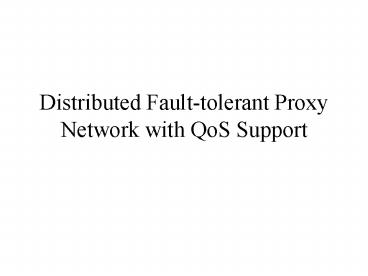Distributed Faulttolerant Proxy Network with QoS Support - PowerPoint PPT Presentation
1 / 8
Title:
Distributed Faulttolerant Proxy Network with QoS Support
Description:
Physical proxies are organized into proxy groups. Each virtual proxy has a home proxy group. Each physical proxy is responsible of a set of virtual proxies. ... – PowerPoint PPT presentation
Number of Views:18
Avg rating:3.0/5.0
Title: Distributed Faulttolerant Proxy Network with QoS Support
1
Distributed Fault-tolerant Proxy Network with QoS
Support
2
Problem Description
- The proxy network as a whole should provide QoS
globally to users. (Solve the merging problem.) - The proxy network should tolerate failures of
individual proxies. - The proxy network should be able to balance load
across individual proxies in order to achieve
better efficiency.
3
Assumptions/Tools
- We know how to do fair schedule in a centralized
fashion. A WFQ variant - Keep some history for each user.
- Dynamically change number of queues
- Initially assume everyone in the same class (or
in several known classes) - Periodically sampling to find violators
- Put violators into separate queues.
- Each queue can be FIFO, which is fast. Sampling
has little overhead (might be just increment
counter). Total number of queue should not be
huge provided there are not too many violators.
4
Assumptions/Tools (cont.)
- There are tools to help build fail-stop proxies
especially against intrusion. - Users are geographically distributed and the
distribution does not change often.
5
High-level Design
- Virtual proxy glue between user and physical
proxy - Static mapping between user and virtual proxy
solves merging problem. - Migration of virtual proxies on physical proxies
(virtual proxies are dynamically mapped to
physical proxies) to balance load and to mask
failure of physical proxies.
6
Design Load Balance FT
Gossip
A Lead
B Lead
Proxy Group A
Proxy Group B
gossip
gossip
- Physical proxies are organized into proxy groups.
Each virtual proxy has a home proxy group. - Each physical proxy is responsible of a set of
virtual proxies. Group members periodically
exchange gossip messages to balance load.
(Virtual proxies migrate inside proxy group) - Group leads infrequently exchange gossip messages
to balance load across proxy groups.
7
Design - Routing
- Inside each proxy group, every group member keeps
a table of current mapping for each group member.
The table is updated in the gossip protocol. - Each group lead keeps two tables emigrant table
and visitor table. (Since migration across proxy
groups have to go through group lead, it is easy
to maintain those lists.) - When a virtual proxy migrates
- Inside group, only involved members update their
lists - Across groups, both involved members and involved
team leads update their tables. - To locate a virtual proxy starting from any
physical proxy - Search locally (usually virtual proxies dont
travel far, so most possibly it can be located
locally. - If failed, pass the request to group lead, and
search globally. - If all failed, return error to user. User should
retry later.
8
Other problems
- Prevent massive propagation of worms/viruses,
which may generate huge amount of traffic to slow
down the whole network. - Prevent intrusion on the application itself.































